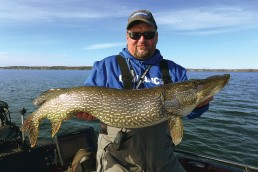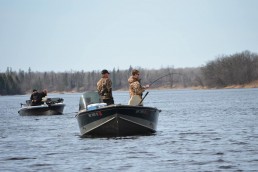SHARE THIS POST
Some of my fondest childhood fishing memories involve sitting in a rented rowboat with my father and drifting a nightcrawler or leech across the lake. The most sophisticated equipment we had was a rudimentary paper lake map to mark communal fishing spots. Our prefishing intel was limited to the bait shop owner’s standard report that might remain scripted for more than a week, or, if we were lucky, a couple fishing tips at the boat launch from an angler who was just leaving the lake.
For many, those days seem like a lifetime ago. With the advent of the internet, and Wi-Fi, smartphones, apps, wireless trolling motor controls, side imaging, 3D sonar and multiple other technology, we have an unlimited toolbox at our disposal. Information is instantaneously streamed and is constantly updating. Plus, technology has advanced our gear to a level of sophistication that few would have imagined a generation ago.
Monofilament has been supplanted by polyethylene line such as Sufix 832 Performance Braid, which is exponentially thinner, stronger and more sensitive than monofilament. We now have tungsten jigs and weights that are smaller in size and sink more quickly than lead. Computers are now used to make the most technologically advanced fishing rods ever available like the St. Croix Legend Elite Series.
Spinning reels have also picked up the slack in the last decade to eliminate rotor arm wobble as well as play in the handles and much-improved front drags. Baitcasting reels are now lighter than ever with magnesium construction and have lightning-fast retrieve ratios of over 7.1:1 and carbon fiber drag materials for silky smooth performance.
Are you enjoying this post?
You can be among the first to get the latest info on where to go, what to use and how to use it!
While these are all invaluable advancements, nothing has impacted my own fishing success and enjoyment more than the current integration of trolling motors and sonar units. As a fishing guide, my primary function is to find fish and then stay on them in the most efficient manner possible to allow my clients to catch them. For that reason, I run a Motorguide i5 trolling motor on my Ranger 620. It’s networked with three Lowrance HDS Carbon units through the Pinpoint Gateway System, which allows me to control my trolling motor on all three of my electronics via their touchscreens. I also have the option of using a hands-free wireless remote system or a wireless foot pedal so I can work from anywhere in the boat and maintain impeccable boat control. The Motorguide i5 is also outfitted with an anchor feature that allows the trolling motor to hold the boat in place indefinitely when the anchor feature is selected. You can then jog the boat in 5-foot increments in all four directions, allowing for precise adjustments in the boat’s position to fish slightly different water from the initial locked position.
I also use 3D sonar as well as side and down imaging. With the 3D transducer, I can look 600 feet to each side of the boat. This allows me to scout water efficiently, and then scan water quickly and drop waypoints on the touchscreen for areas holding fish or locations on key pieces of structure. With the 3D technology, not only are you aware that fish are under the boat, but you also know exactly which side of the boat they are located and how they’re relating to the structure. You can also waypoint suspended fish vertically in the water column.
To understand the value of this technology on the water, take for example a recent walleye trip I took to Door County this past spring. Cold, unstable weather had walleyes scattered across miles of featureless flats instead of staging in more concentrated packs at the mouths of rivers where they would eventually spawn. The schools of walleyes were small—only three to five fish in each pod. If you blindly drifted as we had done in prior years you might’ve had several hours in between contacting the next pod of active fish. This would’ve made for a long day on the water with a lot of dead time and waters devoid of fish. Instead, we used the side imaging on the unit to locate the smaller schools of walleyes. We then created waypoints just off of them and used the navigation feature to quietly take us to those locations via the trolling motor. We then strategically casted to these isolated schools of walleyes. This greatly reduced the downtime in between bites by establishing a milk run of high-probability spots.
The days of aimlessly drifting and hoping to connect with fish are a thing of the past for tech-savvy anglers. Take advantage of today’s fishing technology to not only become a better fisherman, but to get more enjoyment out of your limited time on the water.
MWO
SHARE THIS POST
Did you enjoy this post?
You can be among the first to get the latest info on where to go, what to use and how to use it!
MWO
We believe being outdoors is good. With more than 1,000 articles each year, MidWest Outdoors magazine is all about sharing outdoor experiences with you—where to go, what to use and how to use it… whether you’re close to home or on that trip of a lifetime.



